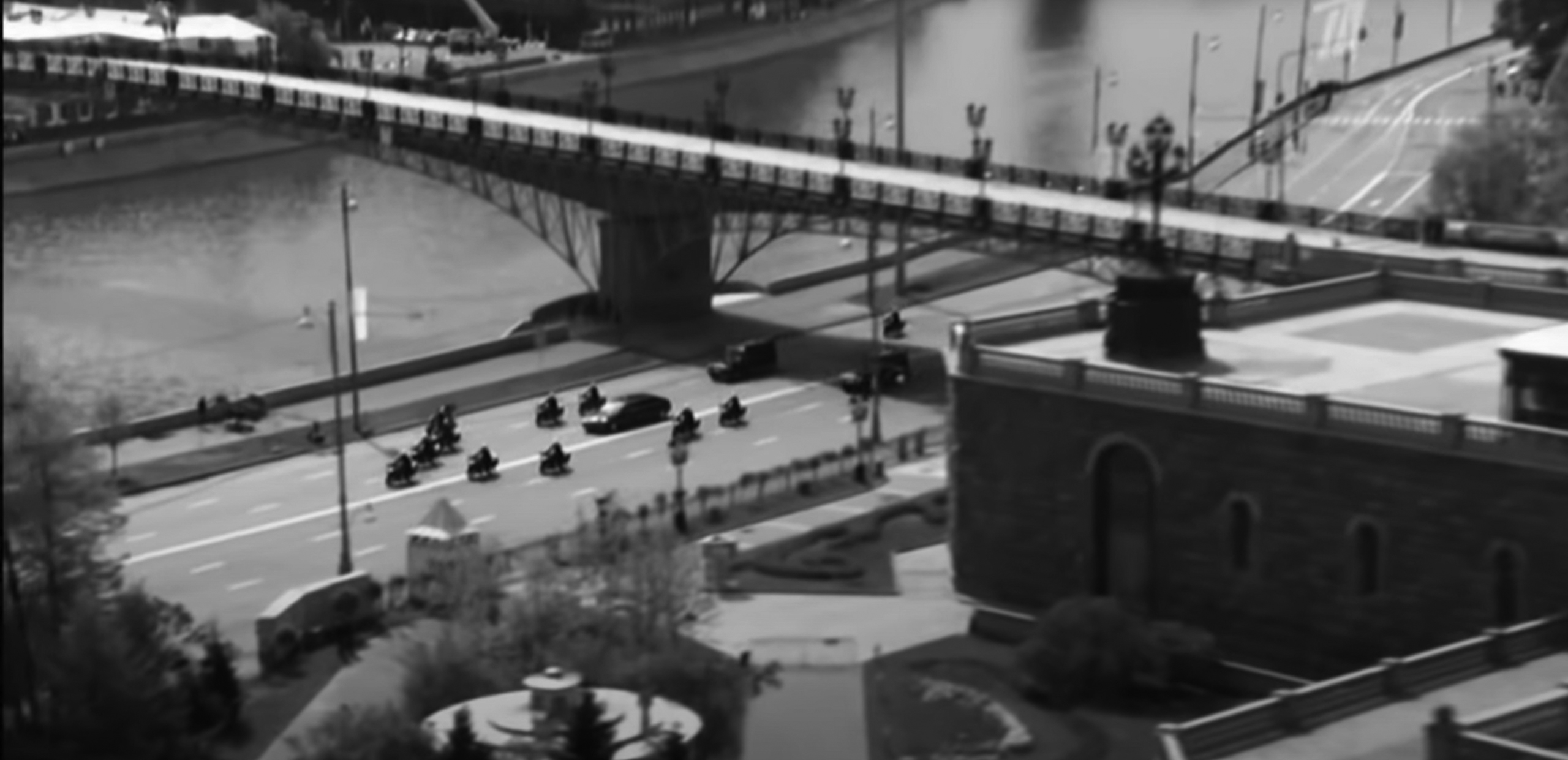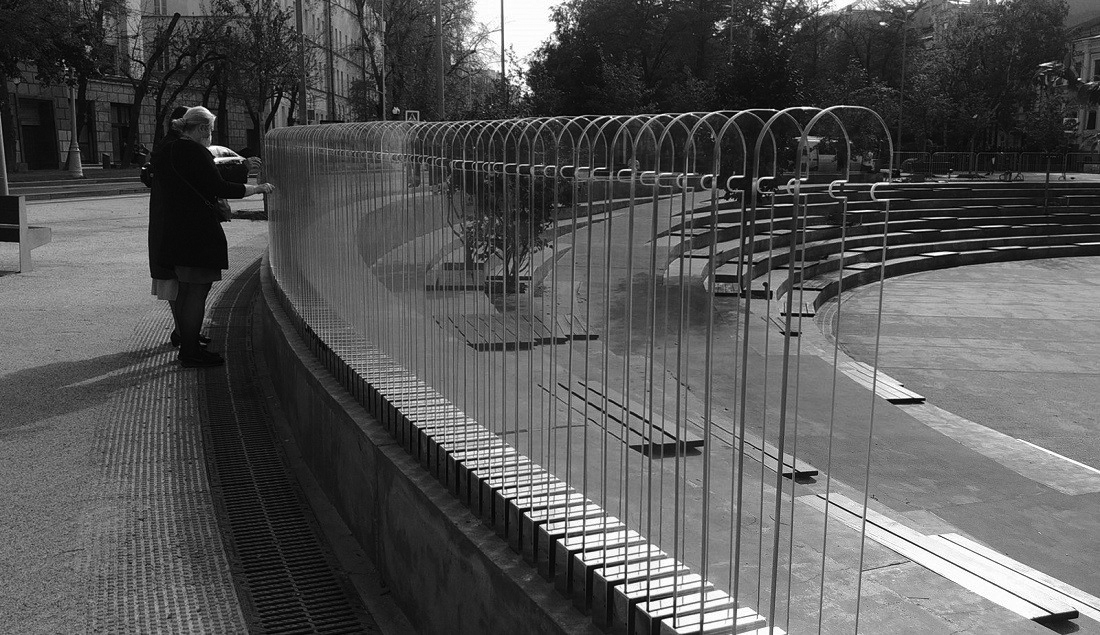Moscow
55.7461° N, 37.6177° E
We meet outside in the freezing cold. After briefly speaking with a security guard, we are allowed inside, past a long queue of people so inadequately dressed you would never have known it was winter. It is December 2011, and I am sitting inside a nightclub called Gipsy, located on Moscow’s exclusive “Golden Island.” Across the table from me are two people: a high-ranking Gazprom official, who happens to be the father of the friends I’m with, and his friend—a Russian oligarch. What for my friend’s dad began as an evening of “hanging out” with his son has turned into a lavish spending spree with unexpected companions coming and going, whispers and contacts exchanged with prolonged firm handshakes, wide smiles, and the kinds of misogynistic jokes that are shared only in the company of certain men. Few people can afford to have this kind of fun, but for those who can, a night on Golden Island, packed with exclusive establishments, affords the opportunity to both geographically and mentally detach from the otherwise agitated environment of Moscow.
Beyond the island’s boundaries, the agitations are mounting. The Arab Spring has played out across Tunisia, Libya, Egypt, Yemen, Syria, and Bahrain, with hundreds of thousands participating in pro-democracy, anti-government protests. In Russia, opposition protests, stirred by the controversial 2011 legislative election, have continued for a year, while Dmitry Medvedev’s first term as the third Russian president is coming to an end. Amidst it all, there is a feeling both of opportunity and indeterminacy. Which is why at some point in the evening I have decided to use this chance meeting with the oligarch to attempt to gain insight into something that for almost any Russian is inaccessible.
“Will Putin recede completely? And might Medvedev’s era produce a path for a democratic Russia?” I ask him.
There is a slight pause and a brief discomfort in the air before the oligarch answers.
“Have you read The Prince by Machiavelli?”
“No.”
“Then do it. It has answers to the questions you ask.”
Five months later, on the 6th of May, 2012, and 650 meters northeast from that nightclub, tens of thousands of people gather on Bolotnaya Square to protest what Russian and international journalists had reported on as a fraudulent presidential election. The protest ends with forceful dispersion, arrests, and prosecutions of civilians.
The next day, the newly elected President Vladimir Putin makes his inauguration cortege ride. His black Mercedes limousine, tailed by two black G-Wagons and surrounded by twelve black motorbikes driven by men wearing epaulettes, navigates the evacuated streets of Moscow towards the Kremlin. It is a spectacular appropriation of the city. Even more, it is a remarkable centralization of Putin’s own identity—and, by proxy, a more general Russian identity. Driving through the empty streets that had been filled with thousands of protestors only the day before, this centripetal ritual marks a new era: an era when a once widely accepted outlook towards westernization is supplanted by notions of “Russia’s special way” and “stability;” an era when the future began to be obfuscated by continuously revived glories of the past, and twenty-one years of inebriated clumsy liberation following the dissolution of the Soviet Union have turned into a withdrawal. Enter the “post-Soviet” condition. The post-Soviet condition is shared by all of the former Soviet republics, but in Russia— starting in 2012 and rapidly transforming after the 2022 invasion of Ukraine—it has achieved a form of condensed time and space which has thickened, taken on flesh, and become artistically malleable.

The post-Soviet is a gray area. Coming out of the collapsed socialist realm, it has failed to integrate into the doctrine of late capitalism. It therefore occupies a liminal space between two grand disenchantments. Such a position is uncomfortable, but the alternative—that of integration—would mean first fully accepting the demise of the Soviet Union as a consequence of the failures of its own ideology and anti-humanist ways, and then repenting for those ways. But Russia is unable to process its past. A prominent spatial example of this denial is Lenin’s mausoleum at the Red Square, which to this day hosts the unburied remains of the founder of Soviet Russia. A more systemic example is the continuous concealing by the Federal Security Service (FSB) of archives related to the period of the Great Purge—a suppression of information that is in direct contradiction with the 1992 presidential decree “On the removal of restrictive stamps from legislative and other acts that served as the basis for mass repression and attacks on human rights.”
Post-Soviet Russia’s inability to process both the past and its consequent failures and integrate into the future requires a coping mechanism: cynicism fills that need. A cynical position is an easy escape and a modus operandi of the post-Soviet. With a sly smile of “getting how things really are” it allows one to occupy a perceived moral high ground without accountability. Cynicism enables the post- Soviet to eliminate any imagined alternatives to itself, resulting in a condition that is ideologically bankrupt and solely reactive.
This reality manifests spatially. It is of no surprise that Moscow has seen its share of attention from renowned architecture firms: Herzog & de Meuron, Zaha Hadid Architects, OMA, Renzo Piano, MVRDV, and more have contributed to the Russian capital of today. A spatial post-Soviet exemplar is Zaryadye Park by Diller Scofidio + Renfro. Proposed by Vladimir Putin in 2012, the modest thirteen-hectare park occupies one of the oldest and historically significant raions adjacent to the Kremlin. It comprises an artificial hill, underground parking, a museum, concert hall, a cantilevering V-shaped bridge over the Moskva river, media center, restaurant, food hall, “ice cave” art installation with sub-zero temperatures year round, hotel-apartment, amphitheater semi-covered with a climatically controlled glass dome, and even vegetation in between. Zaryadye is a vanguard of a post-Soviet public space, a place so saturated with program that it leaves no space for self-expression and therefore, while allowing one to be in public, leaves no space for publicness. This is a necessary feature of the post-Soviet public space: to reduce publicness and contain contradictions.


In rare cases when the post-Soviet space is not prescribed and allows room for expression, it can sometimes result in its own subversion. Conflicts arise. The urban amphitheater at Khokhlovskaya Square, known colloquially as the Pit (Yama), was opened in 2017. Designed by Strelka KB, an urban development consulting company and affiliate of Strelka Institute, the space is an open, semicircular seating area cascading from ground level down to a spacious stage with an excavated, sixteenth-century wall foundation serving as a skene. Such casual museumification allowed for myriad publicness: young people playing chess, dancing, skateboarding, and playing frisbee while older generations enjoyed the vibrancy and observed the ancient centerpiece. The popularity of the project spoke of “well-crafted placemaking.” At night, however, the Pit transformed into a venue for loitering, prohibited public drinking, loud music, antisocial behavior, and sexual activities. Recurring conflicts led to altercations with the police. Rather than confronting any number of reasons or symptoms that led to its malfunctions—such as overly restrictive laws on public drinking, a general acceptance of acts of intolerance and aggression, or police brutality—the contradictions were quietly swept under the rug, and in 2020 the Pit was quietly enclosed by a fence 1.5 meters in height with two easily policed entrances. The “Pit,” together with publicness, brought up inner contradictions and a deeply atomized state of Muscovites: locals vs non-locals, young vs old, rowdies vs purists, police vs everyone.
It is July 2, 2016, and I stand among a large group of people, dressed predominantly in black, on the sidewalk opposite MoZAL, a Moscow-based machine-tool factory. MoZAL shut down in 2010 and has since rented out its facilities for various needs. For several weeks, more than one hundred people have been transforming the complex into a setting for a three-day techno festival that will host thousands of visitors. But the festival never happened. A group of men dressed in civilian clothes arrived with the police and forced everyone to vacate the premises, leaving behind tools, documents, and unfinished work.
A lot of theories are hypothesized on the sidewalk that day. Perhaps the festival sponsors have been caught laundering money—or they have not been laundering enough. Or maybe the high-ranking police officials never received their proper cut for looking the other way and ignoring potential drug consumption (par for the course at this kind of event). Or is it because techno culture does not ideologically fit into the Russian context—and therefore a crackdown is a part of a broader cultural policy. Meanwhile a young man, an artist, with a pale face and tired eyes smokes a cigarette as he looks across the road towards the previously blank wall of an administrative building which he has overpainted with a monumental unfinished mural.
We linger on the sidewalk for about an hour before somebody calls a cab and we drive away. In the moment, receiving no clear explanation seemed normal since all the sidewalk theories made sense all together and it made no difference which one was factual. The general fact was that at this point in time a certain amount of contradictions related to the festival became too big to be handled by patrons or the municipality or the police, and therefore work and expectations had to be quietly sacrificed to an undefined status quo.
The status quo is the post-Soviet’s most desirable condition, a perfect instantiation of proclaimed stability. To preserve this status and the post-Soviet itself, a container is required, i.e., an identity. An ideology will not work due to the cynical coping mechanism. And nostalgia can only take you so far because the past cannot enchant and incorporate everyone due to the breakneck speed of the global.
This text has been excerpted from forA issue #1: Frictions. To read the full essay, purchase the journal here: https://birkhauser.com/books/9783035628517
Konstantin P. Kim is a Moscow-born architect, writer, and political activist. His interests lie in understanding the developments of architectural languages and forms of production of architecture as processes of liberation. His current research analyzes the work of architecture groups through a lens of solidarity, in particular Soviet avant-garde groups and fascist rationalist groups of the 1920s and 1930s, and traces transformations of architects’ solidarity in tandem with works through Stalinism in the USSR and the decline of fascism in Italy into Soviet modernism and postwar Italian architecture. In 2020, together with KaWai Cheung and Aleksa Milojević he co-founded, Half-circus, a traveling architectural assemblage that operates between Europe, Russia, and the US.